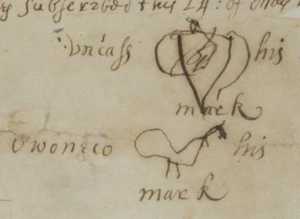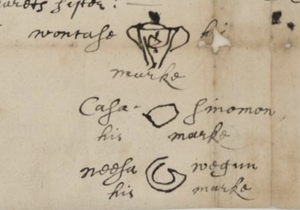
top: Uncas's mark
bottom: Owoneco's mark
From "Agreement between Mohegans and Colonists," May 14, 1678. Yale Indian Papers Project
https://findit.library.yale.edu/catalog/digcoll:3895

From Uncas' Map of a Portion of the Pequot Territory, August 4, 1662.
top: Uncas's mark
middle: Robin Cassasinamon's mark
bottom: Nesahegen's
mark. Yale Indian Papers Project
https://findit.library.yale.edu/catalog/digcoll:3475
The Sign of Uncas
Uncas and other Native American leaders signed colonial documents. In these two examples, they did not write their names using English letters. They signed with a drawing. Their marks expressed more than just their names.
Mohegan Tribal authority Melissa Tantaquidgeon explained Uncas's mark.
“His mark was a representation of not only himself but some of his very most important beliefs.
… You’ll notice that there’s a heart at the center with something piercing the heart. Very frequently, when Uncas signed documents where he gave away tribal land, you actually see a bloodletting from his heart as he gives away each parcel of tribal land.
You’ll also notice though that beneath that is a pipe and the pipe represents the fact that he has made a gesture of friendship and goodwill toward the non-Indian people.”
Source: “The Mark of Uncas,” by Kenneth A. Simon, Simonpure Productions, 2002. https://vimeo.com/286572887
Owoneco was Uncas's oldest son.
Robin Cassasinamon was a Pequot. He survived the Pequot War an became a Pequot tribal leader.
Nesahegen was a sachem of the Poquonnock.
